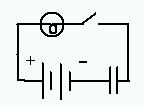
lines to the pylon are insulators
Some materials -- metals in particular -- are good conductors. When a voltage is applied (which means, when they are placed in a circuit containing a battery or some other source of electrical energy), a current flows. There are also poor conductors, like pencil lead and people and salty water, which still conduct but the current is smaller. Then there are insulators, like glass and wood and paper and plastic, for which the current is too small to be detected.
 |
| The vertical bars connecting the power lines to the pylon are insulators |
The size of the current that flows depends on the voltage that is applied,
however. Wood is generally an insulator, but
a tree will pass a measurable current when hit by a
lightning bolt (1,000,000 Volts). To allow consistent comparison,
we can define a quantity, the electrical resistance, which is
the ratio of the voltage that is applied to the current that results.
It is useful to compare the flow of a fluid to an electrical current. The flow rate of a liquid in a pipe is determined by the pressure difference between one end of the tube and the other, and by various other factors such as the length and diameter of the pipe. A wide pipe permits a large flow rate, while a long one tends to decrease the flow. We can also imagine that there is a difference between pipes that are rough and smooth inside.
We can say something very similar about electricity. The current (measured in amperes) in a wire is determined by the voltage difference between one end of the wire and the other, and by the resistance of the wire. The resistance is lower (large current) if the wire is short and thick, but is higher (smaller current) if the wire is thin and long.
There is also a difference between wires made of different materials. Copper and silver and aluminum are the best conductors, and all metals are very good conductors relative to anything else. Acidic or salty water and a few materials like pencil lead are good enough conductors that we can detect the current they permit (for example, using the light-emitting diode).
Although the concept of resistance is frequently useful, there are exceptions. For example, consider the light emitting diode. It will not do anything at all unless the voltage is more than 1.6 V (in contrast, a light bulb with low voltage is still glowing, but very dim and red). We could claim that they have a resistance that changes with the applied voltage, but this is not a very useful concept.
Resistors and capacitors
When we connect a capacitor to a battery, we store a certain amount of charge in it. Then when we connect it to some other device, the charge runs out. A device like the buzzer that only needs a small current will run for a long time, while a light bulb quickly drains the charge. The buzzer is behaving like a high resistance, while the light bulb is behaving like a low resistance.
In the case of the circuit  , the battery is driving current through the light bulb.
This stores charge in the capacitor, until it is so full that the
battery cannot push any more in. As the current decreases and then
stops, the light bulb gets dim and goes out. This happens quickly
when you use the light bulb, but a long time, using the buzzer --
we could compare this to trying to siphon water into a bottle using
a wide tube, or a very thin one. The buzzer and the light bulb are
telling you when the current is flowing.
, the battery is driving current through the light bulb.
This stores charge in the capacitor, until it is so full that the
battery cannot push any more in. As the current decreases and then
stops, the light bulb gets dim and goes out. This happens quickly
when you use the light bulb, but a long time, using the buzzer --
we could compare this to trying to siphon water into a bottle using
a wide tube, or a very thin one. The buzzer and the light bulb are
telling you when the current is flowing.
Check the box when you are
done:
Next:Discussion of resistance